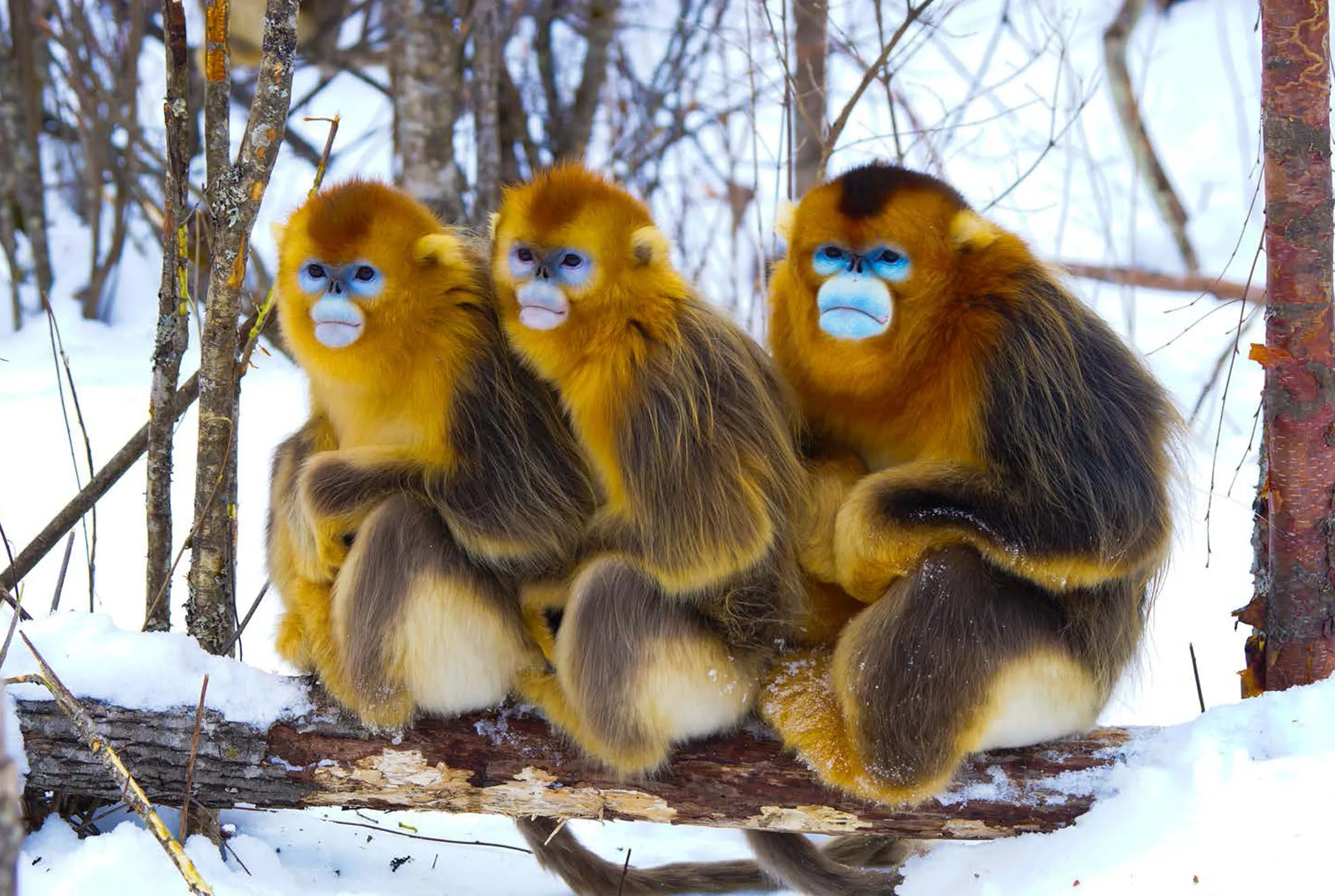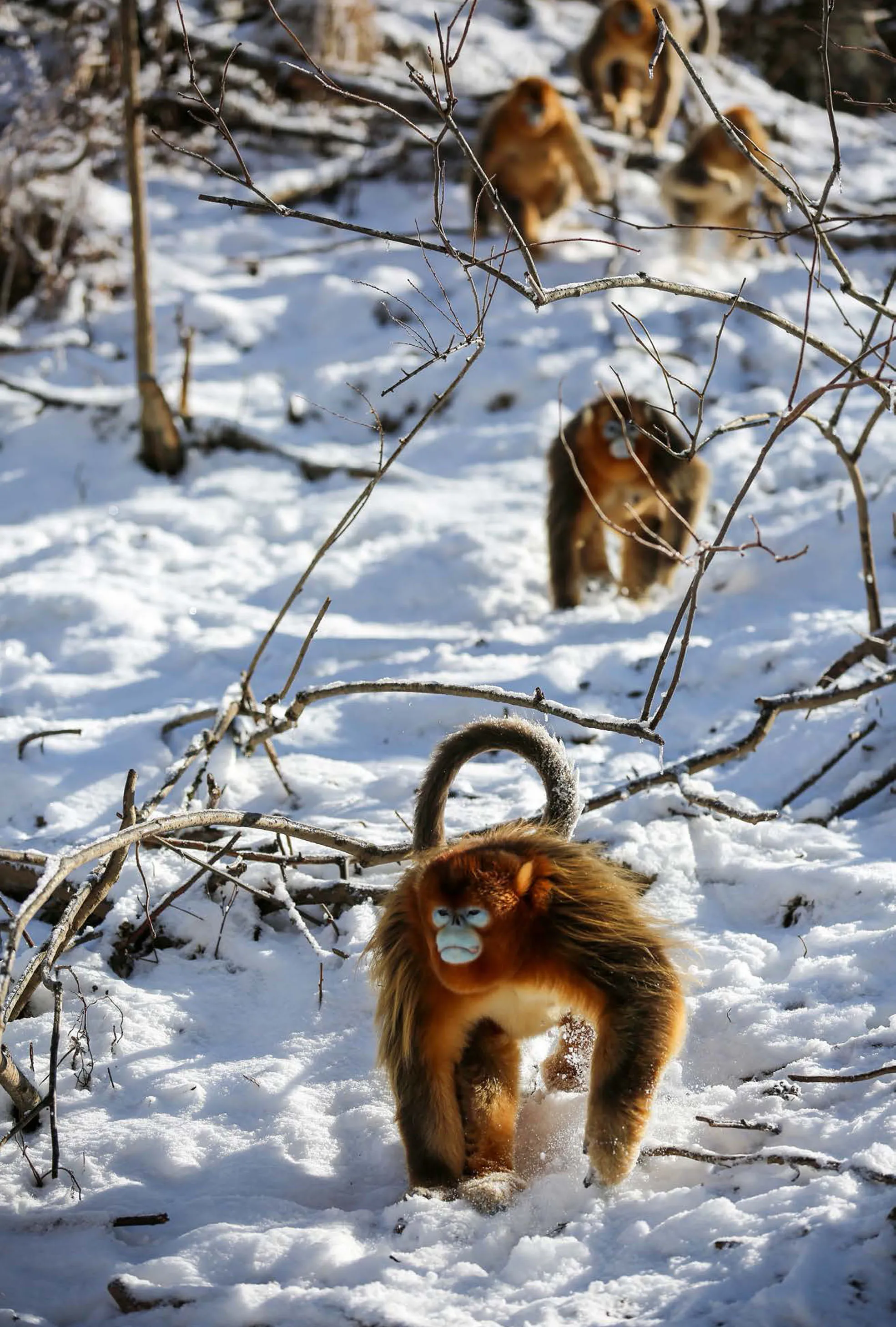The 3rd Census Report of Shennongjia Golden Snub-nosed Monkeys
2020-04-15TextbyZhaiXingboZhangShanshanZhaoBeiXiangPingyang
Text by Zhai Xingbo,Zhang Shanshan,Zhao Bei & Xiang Pingyang

Shennong Valley 神农谷
Snub nose,blue face,yellow robe...the golden snub-nosed monkeys,one of China’s national treasures,are the flagship species for the biodiversity conservation in Shennongjia,and praised as the “Elves from the Roof of Central China.”
However,their presence in Shennongjia was not discovered until 1978.This discovery extended the distribution range of the Sichuan golden snub-nosed monkey population from 101° to 105° E to Shennongjia,Hubei Province from 110° 03’ to 110° 33’ E.Shennongjia has thus become the easternmost “border town” of the world’s golden snub-nosed monkeys.
For more than 40 years,the number of golden snub-nosed monkeys in Shennongjia has been a topic of public concern,for which the census is one of the basic means to keep track.From April to September,2019,a team of more than 50 members headed deep into the mountains of Shennongjia,launching the third survey to take inventory of the latest “national treasure”:1,471 golden snub-nosed monkeys—nearly three times as many as those in the first census.
Easternmost Border Town
“Farther east,there are no golden snub-nosed monkeys left on earth,” said Liao Mingyao,former director of Shennongjia National Nature Reserve Administration,who had twice conducted the field surveys of golden snubnosed monkeys in Shennongjia.“Shennongjia is the first and last frontier at the easternmost end of the golden snub-nosed monkeys of the world.By protecting the ecology of Shennongjia,its population of golden snub-nosed monkeys is well preserved.”
According to Liao Mingyao,there are currently only five populations of golden snubnosed monkeys in the world—Sichuan golden snub-nosed monkeys,Yunnan golden snubnosed monkeys,Guizhou golden snub-nosed monkeys,Vietnamese golden snub-nosed monkeys,and Myanmar golden snub-nosed monkeys.Except for the Myanmar golden snub-nosed monkeys and the Vietnamese golden snubnosed monkeys,the remaining three are endangered species living in China.The snub-nosed monkeys in Shennongjia are an independent subspecies of the Sichuan snub-nosed monkeys,as well as the latest species found in China.Shennongjia is the only habitat for the Hubei subspecies of Sichuan snub-nosed monkeys.

A baby golden snub-nosed monkey frolicking in the treetops Photo by Guo Yuming出生不久的金丝猴在树梢嬉戏 图/ 郭裕铭
仰天鼻、蓝面孔、一身黄袍……“国宝”金丝猴是神农架生物多样性保护的旗舰物种,被誉为“华中屋脊精灵”。
然而,它们在神农架的身影直到1978年才被发现。这将川金丝猴种群分布区间从东经101°至105°延伸到东经110°03′至110°33′的湖北省神农架境内。神农架也因此成为世界金丝猴最东部“边城”。
40 多年来,神农架到底有多少只金丝猴,一直是大众关心的话题,种群调查是基本手段之一。2019年4月至9月,一支50 余人的调查队伍向神农架深山进发,启动了第三次调查,摸清了“国宝”的最新“家底”:1471 只,是第一次普查数量的近3 倍。
发现最东部“边城”
“再往东,地球上就没有金丝猴了。”曾两次主持神农架金丝猴野外调查的原神农架国家级自然保护区管理局局长廖明尧说,“神农架既是全球金丝猴最东端的第一道屏障,也是最后一道,保护好了神农架的生态就保住了神农架金丝猴这一种群。”
廖明尧介绍,目前全球金丝猴仅存5 个种群——川金丝猴、滇金丝猴、黔金丝猴、越南金丝猴和缅甸金丝猴。除缅甸金丝猴和越南金丝猴外,其余3 种均为我国特有濒危物种。神农架金丝猴是川金丝猴的一个独立亚种和发现最晚的一个种群,神农架是川金丝猴湖北亚种唯一栖息地。
1978年,科考人员首次在神农架发现金丝猴;20世纪90年代初期,神农架进行了第一次普查,初步判断有500 多只;2005年,第二次普查获得准确数据——1282只。
14年过去了,家族壮大了吗?栖息地变了吗?这些是此次调查想要弄清的问题。
“开展全面系统的新一轮调查,不仅可准确掌握神农架金丝猴种群数量、分布、活动规律等,也是评估保护成效,为神农架今后的生态保护和管理决策提供支撑。”神农架国家公园管理局科学研究院院长杨敬元说。
脚步丈量“流动”家
“调查相当于金丝猴的‘人口普查’,但猴子身手敏捷、四处活动,调查起来很难。”神农架国家公园管理局科学研究院副院长姚辉说,“调查工作组预先制定实施方案,对金丝猴集中分布区,设置17 个调查小区,3-4 人为一组,采用网格化、拉网式线路调查法、社群大小调查法、实体观察法等,全覆盖跟踪调查金丝猴种群及栖息地。”

A monkey couple snuggling up to each other in the snow Photo by Shu Renqing 雪中情 图/舒仁庆
In 1978,scientific researchers discovered golden snub-nosed monkeys in Shennongjia for the first time.In the early 1990s,the first census of these monkeys in Shennongjia was conducted,the preliminary estimate being more than 500 in the area; and in 2005,the second census obtained an accurate figure—1282.
Fourteen years have passed.Has the family grown? Has the habitat changed? These are the questions that this survey wants to clarify.
“A new round of comprehensive and systematic investigation can not only accurately grasp the population size,distribution and activity rules of golden snubnosed monkeys in Shennongjia,but also evaluate the protection effect,and provide support for the future ecological protection and management decision-making here,” said Yang Jingyuan,chairman of the Scientific Research Institute of Shennongjia National Park Administration.
Measuring the “Mobile” Homes
“The survey is equivalent to a ‘census’ of the golden snubnosed monkeys,but the monkeys are agile and mobile,and thus difficult to trace and investigate,” said Yao Hui,deputy chairman of the Scientific Research Institute of Shennongjia National Park Administration.“The investigation working group has for mulated an implementation plan in advance.For the core distribution area of the golden snub-nosed monkeys,17 investigation communities are set up,with three to four members in a group.Various methods including grid survey,route survey,community size survey,and entity observation are used to fully cover and track the population and habitat of the golden snub-nosed monkeys.”

Three monkeys sitting in a row Photo by Fang Jianli 三猴开泰 图/方建丽
“每组配备红外相机、高倍望远镜、摄影摄像机、手持PDA。猴叫声、粪便、毛发……调查中,关于金丝猴的一切蛛丝马迹,都能被录制、拍摄实时上传,供所有队员精准掌握猴群行踪。”姚辉说,相比2005年调查,本轮调查多了高科技设备支撑,更便捷。
精准掌握金丝猴的生活习性和种群特征也是调查员的必备技能。“7 时至11 时左右活动,11 时以后到14 时期间午休,午睡后接着活动,18 时以后就不再迁徙了,夜宿到第二天早上7 时左右;金丝猴以家庭为单位,一个家庭由一位雄猴家长、若干只成年雌猴和一群婴猴组成,家庭成员数量从几只到几十只不等。”调查员陈华介绍。
金丝猴是大山“精灵”,多栖息于神农架原始森林腹地。猴子迁徙1 个小时路程,人类或许要走1天,为了防止跟丢猴群,调查组规定,17 时以后发现猴群的小组,当晚就在猴子栖息地周围安营扎寨,按兵不动,待天亮接着跟踪。
“天不亮就出发,夜晚伴着星辰返回,遇峭壁山涧拦路,还得另辟蹊径、绕路前行,下雨天山滑难行、密林里蚂蟥侵袭,饿了啃面包馒头、渴了喝口山泉水……”调查员杨利成在调查日记中写道。
50 余人,100 多天,累计步行43200 余公里,足迹踏遍神农架及毗邻的兴山和巴东三个保护区的高山密林,终于完成本轮调查。
保护与研究并重
调查结果显示:神农架现有川金丝猴种群10 个,分布面积约为354 平方公里,10 个川金丝猴种群直接计数统计数量为1471 只。金丝猴种群数、总数量、栖息地面积较2005年的调查数据分别增长25%、14.7%、 68.6%。
结果可喜,回望金丝猴保护之路,也并非波澜不惊。
1958年到1981年,神农架处于大开发时期,持续砍伐原始森林,此间虽极少发现,但在食物匮乏的冬季,却能看到饿死雪中的金丝猴。
“Each group is equipped with an infrared camera,a high-power telescope,a video camera,a hand-held PDA,etc.With their help,monkey calls,excrement,hair,and any other trace of golden snub-nosed monkeys could be recorded,photographed,and uploaded in real time,so that all the team members can accurately grasp the whereabouts of the monkeys,” Yao Hui said,and that compared to the 2005 survey,this round of surveys had more hightech equipment support and was easier to conduct.
Accurately keeping track of golden snub-nosed monkeys’ living habits and population characteristics is also an essential skill for investigators.“Moving about from 7 am to 11 am or so,taking a nap from 11 am to 2 pm,and going on with their activities after siesta,they no longer migrate after 6 pm; they stay overnight until around 7 o’clock the next morning.Golden snub-nosed monkeys live in families which consists of a male parent,several adult female monkeys,and a group of baby monkeys.The number of family members ranges from several to a few dozens,” said Investigator Chen Hua.
The golden snub-nosed monkeys are the “elves” of the mountains,and most of them inhabit the hinterland of the Shennongjia virgin forest.The distance that monkeys travel for an hour may take humans a whole day to cover.In order to prevent the monkeys from being lost,the investigation team stipulated that the team which found the monkeys after 5 pm should set up a camp around the monkey habitat that night and stay still until they continue their tracking at dawn.
“We start before daybreak and return at night.When we encounter cliffs and streams,we have to find another way and make a detour.On rainy days,the mountains are slippery and difficult to walk.In dense forests,leeches attack.When we’re hungry,we have no choice but to eat bread or a bun; we have to drink mountain spring water when we’re thirsty...” investigator Yang Licheng wrote in his survey diary.
More than 50 investigators finally completed this round of investigation in over 100 days,covering a total of 43,200 kilometers on foot through the dense alpine forests in the nature reserves of Shennongjia,Xingshan and Badong (two adjacent counties).
Both Protection and Research Work Are Equally Important
The survey indicates that there are 10 Sichuan golden snub-nosed monkey communities in Shennongjia with a distribution area of about 354 square kilometers,and the number of Sichuan golden snub-nosed monkeys directly counted is 1471.Compared with the 2005 survey data,the number of golden snub-nosed monkey communities,the total population,and the habitat area have increased by 25%,14.7%,and 68.6% respectively.

A group of monkeys lining up down the mountain to get fed Photo by Guo Yuming金丝猴雪天排队下山接受人工补食 图/ 郭裕铭
2000年,神农架林区全面禁伐。2005年冬季,金丝猴接受了人工投食。同年,神农架搭建了中国首个野外金丝猴研究平台——大龙潭金丝猴野外研究基地。2016年,神农架国家公园体制试点运行,随之出台史上最严保护立法——《神农架国家公园保护条例》。2018年,神农架国家公园建成3 类共25 处野生动物通道,为野生金丝猴迁徙提供便利,促进神农架金丝猴种群交流。
2019年4月26日,为呵护“国宝”栖息,神农架金丝猴保护基金会揭牌,当日即收到首批爱心企业和个人捐赠400 万元,善款主要用于开展金丝猴科普科教和志愿者活动,完善保护设施、提升保护能力等。
保护力度空前,研究进度不减。
“金丝猴的早期妊娠诊断技术”“关键营养因子调控神农架金丝猴繁殖力技术研究”“金丝猴疾病流行病学研究”……依托大龙潭金丝猴科研基地,自2005年开始,全国近20 家科研单位、高校参与金丝猴项目研究,先后培养70 名硕士、17 名博士。
“以前,提到神农架,很多人首先会想到‘野人’。如今,再提神农架,人们还会想到金丝猴。”神农架国家公园管理局副局长柳健雄说,金丝猴成了神农架生态保护成果的“检验者”,成为神农架新的形象“代言人”。
The results are encouraging.However,when looking back on the protection of the golden snubnosed monkeys,it is full of ups and downs.
From 1958 to 1981,Shennongjia went through a period of rapid development,with the virgin forests continuing to be cut down.As a result,when food was scarce in winter,the golden snub-nosed monkeys could be seen starving to death in the snow,which is rarely found today.
In 2000,the Shennongjia forest area was wholly banned from logging.In the winter of 2005,the golden snub-nosed monkeys received artificial feeding.In the same year,China’s first wild golden snub-nosed monkey research platform—Dalongtan Golden Snub-nosed Monkey Wild Research Base—was established in Shennongjia.In 2016,the pilot program of Shennongjia National Park System was launched,the most stringent protection laws in history were subsequently introduced,called the Shennongjia National Park Protection Regulations.In 2018,Shennongjia National Park established a total of 25 wildlife passages in three categories,which have facilitated the migration and promoted the population exchange of the snubnosed monkeys in Shennongjia.

Dajiu Lake veiled in mist 雾荡九湖
On April 26,2019,Shennongjia Golden Snub-nosed Monkey Conservation Foundation was unveiled for the purpose of protecting the habitat of the “national treasure.” On the same day,it received a first wave of donations of 4 million yuan from concerned enterprises and individuals.The donations are mainly committed to the scientific,educational,and volunteer activities circled around the golden snub-nosed monkeys,thus improving protection facilities and capacities.
The protection is unprecedented,and the research progress is unabated.
Many research projects,such as “Diagnostic Technology of Golden Snub-nosed Monkeys’ Early Pregnancy,” “Research on Key Nutrient Factors Regulating the Fertility of Shennongjia Golden Snub-nosed Monkeys,” and the “Epidemic Research of Golden Snub-nosed Monkey Disease” have been sponsored by national authorities.Since 2005,relying on the research base of golden snub-nosed monkeys in Dalongtan,nearly 20 scientific research institutions and universities in China have participated in research projects on golden snub-nosed monkeys,which have cultivated 70 masters and 17 doctors in this field successively.
“In the past,when mentioning Shennongjia,many people first thought of ‘savages.’ At present,when referring to Shennongjia,people will think of golden snub-nosed monkeys,” said Liu Jianxiong,deputy director of the Shennongjia National Park Administration.The golden monkeys have become the “eye-witness” of Shennongjia’s ecological protection achievements and the “spokesman” of Shennongjia’s new image.(Translation:Qing Run)
